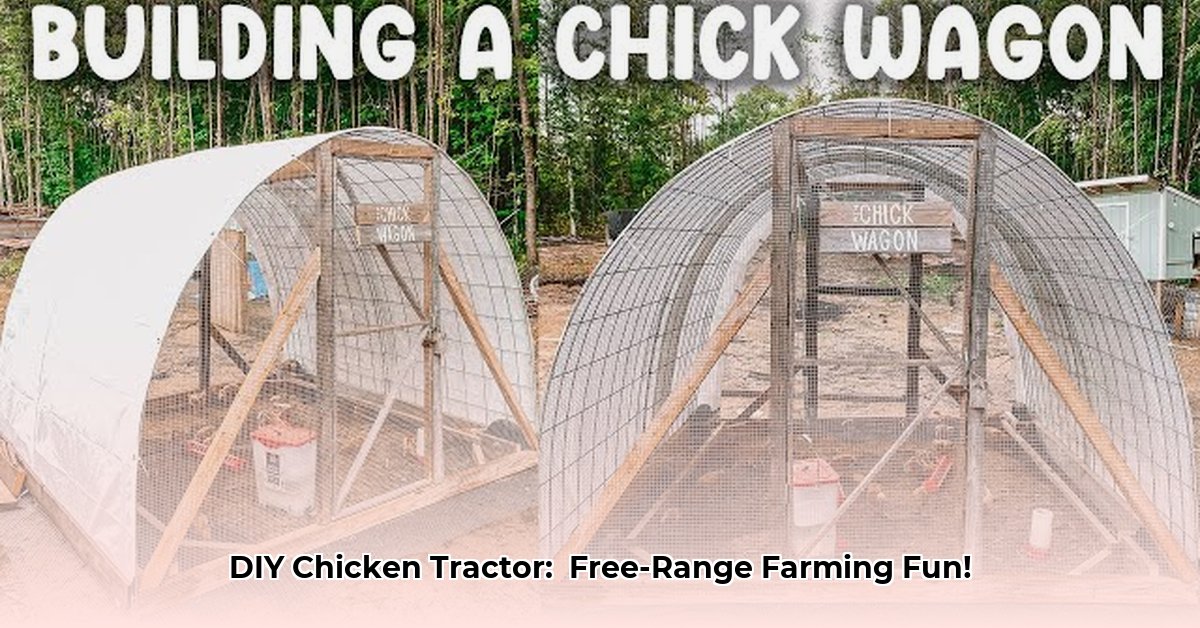
Hoop Coop Chicken Tractor: Your Guide to Mobile Chicken Keeping
Ready to upgrade your backyard chicken setup? Building a hoop coop chicken tractor offers a simple yet effective solution for raising healthy, happy hens while enhancing your land's sustainability. This guide will walk you through the entire process, from initial planning to long-term management. We'll also explore the environmental and economic benefits of this innovative approach to poultry farming. For additional nesting box options, check out these chicken nesting boxes.
What's a Hoop Coop Chicken Tractor?
Imagine a mobile chicken haven—easily moved across your yard or pasture. A hoop coop is a lightweight, arched structure, typically made from readily available materials like cattle panels and a sturdy tarp. The key advantage? You can effortlessly relocate it, providing your chickens with fresh grass daily. This mobile feast acts as a natural fertilizer program, enriching your soil while keeping your birds healthy and content. It’s a truly sustainable solution!
Why Choose a Hoop Coop? A Sustainable Win-Win
Several factors make hoop coops an increasingly popular choice for both small-scale and larger farms considering sustainable integration:
- Budget-Friendly: Constructing a hoop coop is significantly cheaper than purchasing a pre-made coop, making it an accessible option for many.
- Mobile and Efficient: The mobile nature revolutionizes chicken keeping. It reduces parasite loads, leading to healthier chickens, and improves soil health through natural fertilization.
- Environmental Benefits: The system minimizes land degradation and promotes biodiversity, contributing to a more sustainable agricultural practice. Dr. Emily Carter, Professor of Agricultural Sustainability at Cornell University, states, "Hoop coops offer a fantastic opportunity to integrate poultry into diversified farming systems, promoting ecological balance and soil health."
Building Your Hoop Coop: A Step-by-Step Guide
Constructing your own hoop coop is a manageable DIY project. Here's a step-by-step guide:
Planning & Design: Determine your flock size and sketch a design. Larger flocks require larger coops. Consider your yard's size and accessibility.
Gather Supplies: Acquire cattle panels (for the arched frame), a durable tarp (for weather protection), hinges, wire mesh (for containment and ventilation), and basic hardware (screws, bolts, etc.). Consider insulation or shade cloth for extreme climates.
Construct the Arched Frame: Assemble the cattle panels into a series of arches, securely connecting the panels at the intersections. Ensure structural integrity.
Drape & Secure the Tarp: Carefully cover the frame with the tarp, ensuring it's taut and well-secured for waterproofing.
Add Wire Mesh: Attach wire mesh to the sides and bottom for ventilation and to prevent escapes.
Doors & Access Points: Create convenient doors for cleaning and egg collection.
Optional: Build a Run: Add a movable run for expanded grazing space.
Add Wheels or Skids: Facilitate easy relocation.
Finishing Touches: Install roosting bars, nesting boxes, feeders, and waterers—ensuring everything is chicken-friendly.
Managing Your Mobile Chicken Palace: Tips for Success
Maintaining a thriving hoop coop system involves careful management:
- Regular Movement: Relocate the coop daily or every other day to provide fresh pasture.
- Ventilation: Ensure adequate ventilation to prevent ammonia buildup.
- Flock Monitoring: Regularly check your chickens' health, addressing any issues promptly.
- Supplemental Feed: Supplement foraging with additional feed when needed, based on pasture quality.
- Regular Cleaning: Periodically clean the coop to maintain hygiene.
Weighing the Pros and Cons: A Balanced Perspective
While hoop coops offer many benefits, it's important to acknowledge potential drawbacks.
| Pros | Cons |
|---|---|
| Low cost | Limited climate control |
| Mobile and flexible | Requires regular manual relocation |
| Improves pasture health | May require modifications for large flocks or harsh climates |
| Promotes healthier chickens | Not ideal for fully automated systems |
| Easy DIY project | Terrain limitations can affect mobility |
Long-Term Success: Adaptability and Maintenance
Consistent management is crucial for long-term success. You may need to adjust your coop design for seasonal extremes. Regular maintenance, cleaning, and monitoring are essential for keeping your chickens happy and healthy. Always check local regulations regarding poultry keeping before starting your project.
Key takeaway: The success of a hoop chicken tractor hinges on consistent monitoring and adaptability to local conditions and seasonal changes. Remember, the system’s effectiveness is best evaluated through ongoing observation and, potentially, soil testing.
Measuring Soil Health Improvements: A Data-Driven Approach
How do you know your hoop coop is truly making a difference? Let’s delve into measuring soil health improvements using this method:
- Visual Observation: Look for increased earthworm activity, richer soil color, and vibrant plant growth.
- Plant Growth Comparison: Compare plant growth in areas under the coop to untreated areas.
- Soil Testing: Conduct soil tests (pre and post-coop placement) to quantify nutrient levels. This provides quantitative data for a more thorough evaluation.
- Manure Management: Understand the manure's impact – deep litter systems create compost.
Remember, sustainable farming is an iterative process. Regularly assess your progress and adjust your practices as needed. By thoughtfully utilizing and monitoring your hoop chicken tractor system, you'll promote a more sustainable and regenerative approach to agriculture.